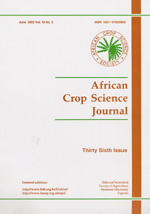
|
African Crop Science Journal
African Crop Science Society
ISSN: 1021-9730
EISSN: 1021-9730
Vol. 25, No. 4, 2017, pp. 387-403
|
 Bioline Code: cs17037
Bioline Code: cs17037
Full paper language: English
Document type: Research Article
Document available free of charge
|
|
|
African Crop Science Journal, Vol. 25, No. 4, 2017, pp. 387-403
| en |
Shoot water content and reference evapotranspiration for determination of crop evapotranspiration
Omondi, J.O.; Mungai, N.W.; Ouma, J.P. & Baijukya, F.P.
Abstract
Determination of water requirement for crops in resource limited areas is challenging, yet worsened by the common assumption that all crop varieties within a species have similar water requirements. The objective of the study was to indirectly determine crop evapotranspiration of soybean varieties, using reference evapotranspiration and shoot water content under tillage and no tillage cultivation. The treatments were no tillage and conventional tillage as main plots, and soybean varieties Nyala, SB19, and SB20 as sub-plots, replicated three times. Crop evapotranspiration (ETC) and crop coefficient (KC) were different among varieties, and increased during growth period. SB20 had the highest KC (0.8437 at 87 days after planting - DAP); followed by SB19 (0.7888 at 70 DAP), and Nyala (0.7026 at 66 DAP). Conversely,water use efficiency (WUE) was 0.58 in SB19, 0.52 in Nyala, and 0.47 in SB20.Validation of the calculated ETC using a crop production function showed a correlation of r = 0.97 between the observed and predicted yields of the three varieties. Furthermore, the normalised root mean square error (NRMSE) and the index of agreement (d) were 0.14 and 0.87, respectively indicating accurate fit. Calculated crop coefficient strongly correlated with observed shoot water content of Nyala (R2 = 1), SB19 (R2 = 1), and SB20 (R2 = 1).
Keywords
Crop coefficient; evaporation; Glycine max; shoot; soybean; transpiration
|
| |
| fr |
Omondi, J.O.; Mungai, N.W.; Ouma, J.P. & Baijukya, F.P.
Résumé
La détermination du besoin en eau de la plante dans des milieux à ressources limitées est un défi, encore aggravé par l’hypothèse commune qui stipule que toutes les variétés d’une espèce ont les mêmes besoins en eau. L’objectif de cette étude était de déterminer indirectement l’évapotranspiration de la culture des variétés de soja, en utilisant l’évapotranspiration de référence et la teneur en eau de la pousse sous labour et sans labour. Les traitements étaient sans labour et avec labour conventionnel comme parcelles principales, et les variétés de soja Nyala, SB19, et SB20 comme sous parcelles, répliquées trois fois. L’évapotranspiration des cultures (ETc) et le coefficient de culture (Kc) étaient différents entre les variétés, et augmentaient durant la période de croissance. SB20 avait la valeur la plus élevée de Kc (0,8437 à 87 jours après plantation - DAP) ; suivie de SB19 (0,7888 à 70 DAP), et Nyala (0,7026 à 66 DAP). Inversement, l’efficience d’utilisation de l’eau (WUE) était 0,58 dans SB19, 0,52 dans Nyala, et 0,47 dans SB20. La validation de l’ETc calculée en utilisant la fonction de production de la culture a montré une corrélation r= 0.97 entre les rendements observés et prédits des trois variétés. De plus, la racine des carrées moyens normalisés de l’erreur (NRMSE) et l’index d’accord (d) étaient 0,14 et 087, respectivement indiquant une concordance précise. La valeur calculée du coefficient de culture était fortement corrélée avec la valeur observée de la teneur en eau de la pousse de Nyala (R2 = 1), SB19 (R2 = 1), et SB20 (R2= 1).
Mots Clés
Coefficient de culture; évapotranspiration; Glycine max; pousse; soja; transpiration
|
| |
© Copyright 2017 - African Crop Science Society
|
|
